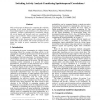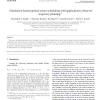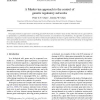700 search results - page 62 / 140 » Transducing Markov sequences |
ICCAD
1994
IEEE
15 years 4 months ago
1994
IEEE
This work presents techniques for computing the switching activities of all circuit nodes under pseudorandom or biased input sequences and assuming a zero delay mode of operation....
115
click to vote
AUTOMATICA
2007
15 years 19 days ago
2007
The sensor scheduling problem can be formulated as a controlled hidden Markov model and this paper solves the problem when the state, observation and action spaces are continuous....
115
click to vote
BIOSYSTEMS
2007
15 years 19 days ago
2007
This paper presents an approach for controlling gene networks based on a Markov chain model, where the state of a gene network is represented as a probability distribution, while ...
92
Voted
ICPR
2010
IEEE
15 years 6 months ago
2010
IEEE
—This paper proposes the sequential context inference (SCI) algorithm for Markov random field (MRF) image analysis. This algorithm is designed primarily for fast inference on an...
150
click to vote
FLAIRS
2008
15 years 2 months ago
2008
Hidden Markov models are a powerful technique to model and classify temporal sequences, such as in speech and gesture recognition. However, defining these models is still an art: ...



